In the previous article, A Guide to Customer Journey Mapping: Part 1 – The Fundamental Layers, I covered the first three layers that help develop a strategic approach to making customer journeys meaningful. This post will cover the fourth and final layer, the end-to-end customer journey itself. This is where all the insights from the first three layers are stitched together.
To recap, the first three layers from the previous post are:
-
Developing unique user personas
To nurture a deep understanding of a segment of customers or users.
-
Determining the persona needs
To recognize the criteria that motivate the decisions each persona will make.
-
Finding the persona experience principles
To discover how to address the needs of a persona throughout the journey.
Step 1:
Break the end-to-end customer journey into stages

The first step is to divide the customer journey into natural stages. Start before the user has ever heard of your brand, and continue beyond the point that they are advocates. An easy way to make these divisions is to determine at which point the persona’s goals will shift. When researching a product or service, the persona wants to find a solution to a business problem. Later, a goal may be finding the best pricing for the solution, but may change later to rapidly integrating a solution with their existing workflows.
You may be tempted to group stages based on organizational processes, because it aligns clearly with which department internally owns the interactions. For instance:
-
Marketing / Sale / Retention
Big mistake! This isn’t your journey, but the customer’s journey. The point is to understand the journey from the customer’s perspective, because you want to improve it from their perspective. Aligning stages with organizational processes is essentially killing the customer-centric nature of the exercise before even starting.
Identify the stages a persona will experience from their own perspective, as if they were the ones documenting it. Remember, there may be some overlap, but each persona will have different journeys. The stages in their journeys should not be assumed to be identical. A person who makes enterprise software decisions will have a vastly different journey than the other members of their team.
A better example of customer journey stages that are user-centric and aligned with the persona’s own perspectives would be:
-
Discovery / Decision-Making / Transaction / Onboarding / Usage
It doesn’t need to be much more complex than that. The goal isn’t to capture every interaction, but to think about how users’ needs change.
Step 2:
Create an overview of each stage of the end-to-end customer journey
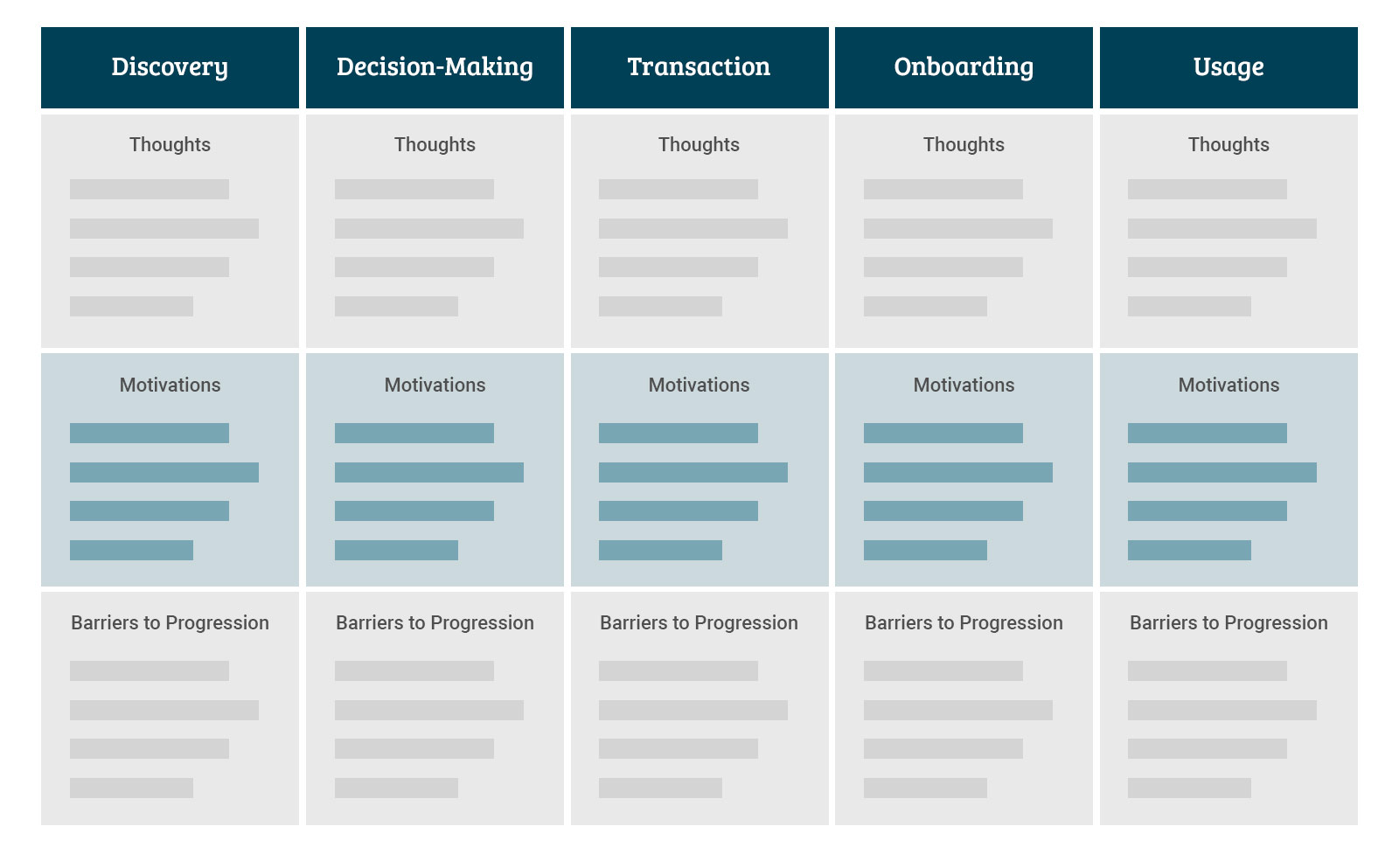
Once your journey is divided into stages, put together an overview of the journey, and document some key details:
Thoughts
This is your opportunity to get into the mindset of your users. Write down, in their own words, things that the persona might be thinking at each stage of the journey. Refer back to your persona needs, because those will accurately represent what’s important. Some examples:
- Is this solution going to help make my team work faster and more effectively? Are there any better alternatives out there?
- As my team grows, will this solution scale with us? How much will pricing change over time?
- Who on my team do I need to involve in training? How easy will it be to get support if they need it?
- Is my team better off? What new problems have been introduced?
Motivations
What are the criteria that will guide the user during each stage? What will be important to them? If the user’s motivations are met and fulfilled, the likeliness of continuing through the journey increases. Some examples:
- Growing an ever-expanding team, in a way that is scalable, while alleviating pain points and saving time and effort.
- Minimizing cost to maximize profit margins.
- Finding a pricing plan or product package that matches the unique needs of the team.
Barriers
It’s not enough to focus on guiding users through the experience, so focus as much on what not to do. You must understand the hidden barriers that prevent users from progressing to the next stage. Some examples:
- Unable to figure out how the product or service will solve a business need. Confusion around adopting the product into team’s daily routine.
- Cost is too high. Competitors have better pricing, or a better aligned package option.
- Product features don’t evolve at a rate the market dictates. Competitors have outpaced the product.
Step 3:
Begin aligning key interactions to stages
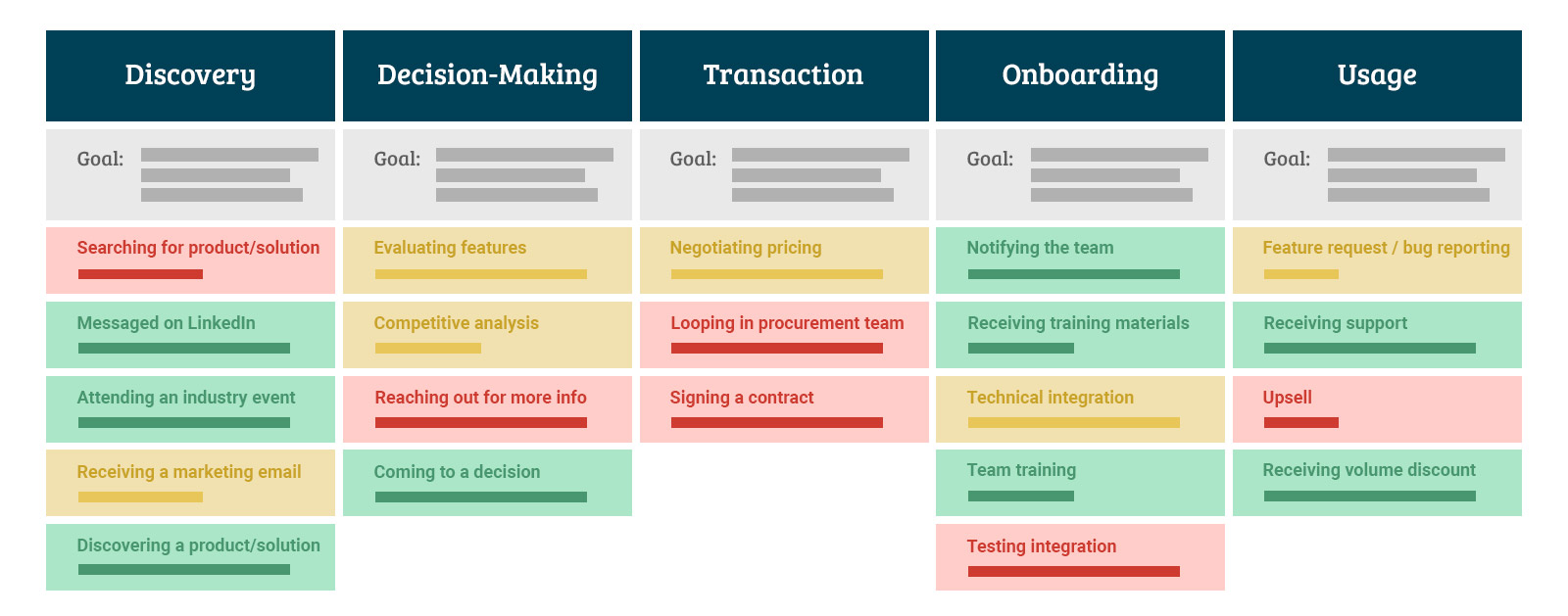
Once you understand the persona’s mindset for each stage in the journey, you’ll know what they’re really trying to do. List some of the key interactions that will occur in the stage. This doesn’t need to account for every touchpoint. It just needs to be a summary of the types of activities users will be doing. For example, in a transaction stage, you can assume the customer will sign a contract or provide payment details. Write it down!
I like to take this a step further, and start introducing some basic emotion assessment on these interactions. Not quite full sentiment scoring yet, but an early summary of whether these interactions are positive, neutral, or negative. For example, users receiving a link to a training manual may feel overwhelmed. Maybe a better option is an in-product guided walkthrough for a more positive experience. Remove training manual, write in-product guided walkthrough instead.
Step 4:
Map the user flows throughout each stage
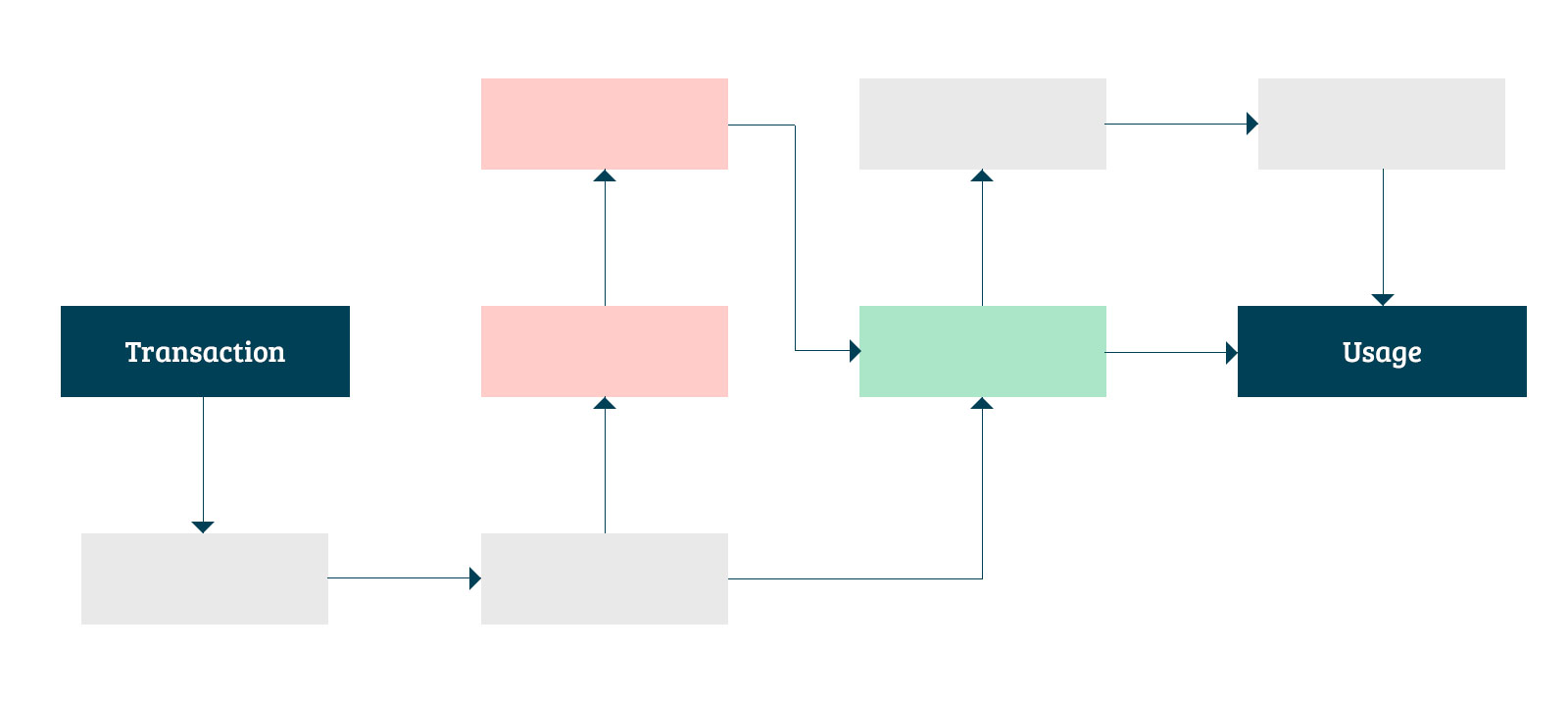
For each stage, map out all the key interactions from the previous step. Then fill in the blanks on how the user transitions through interactions. Remember to include both a happy path (ideal conditions) and sad path (running into problems). This is a great opportunity to identify gaps in the journey. You’ll start to see the bigger picture of where customers may need additional support to guide them more effectively.
Be sure that all the entry points into the stage are accounted for with their own paths. An individual arriving through a web search will have a different discovery stage than somebody with a referral code.
Remember, the goal here is guiding the user through the journey. If there are dead-ends or gaps in the stage flow, that needs to be fixed. The flow for each stage should start at the exit from the previous stage, and end at the entrance to the next stage.
Step 5:
Conduct sentiment scoring across the end-to-end customer journey
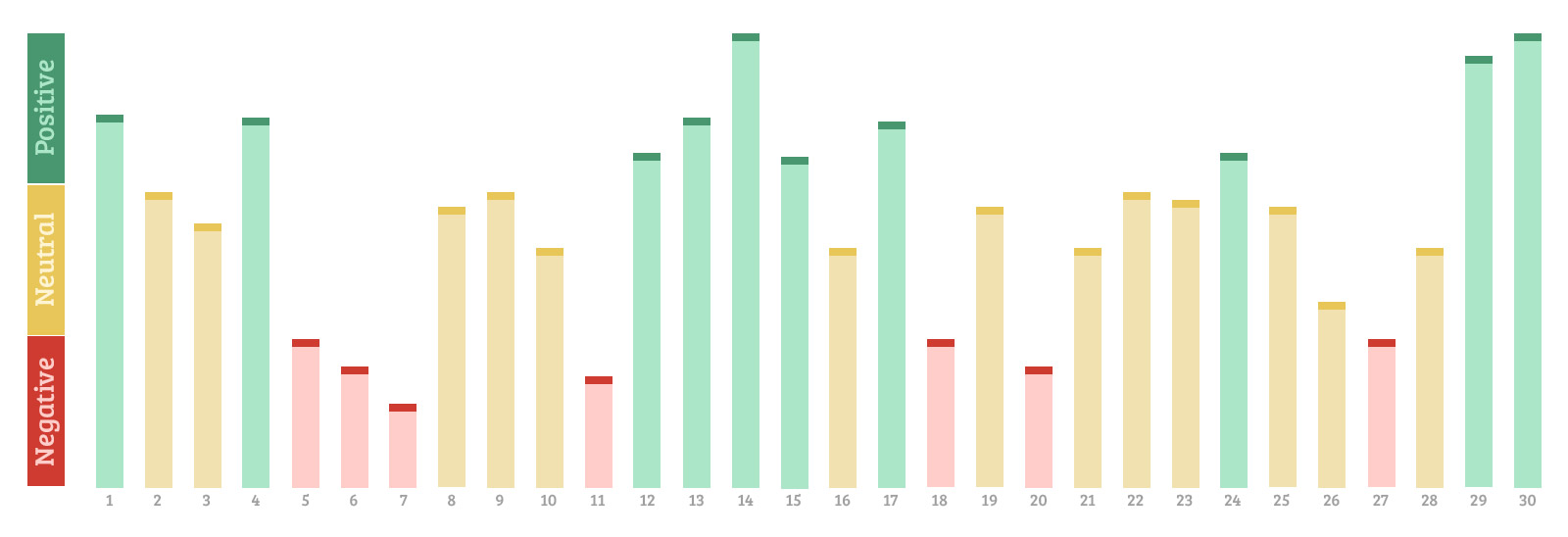
In the previous step, you mapped the journey out with happy paths and sad paths for individual stages. In this step, focus on singular paths through that network of interconnected touch points throughout all stages. I like to add an additional dimension to this, and show the interactions as bars on a bar graph. The x-axis lists touch points, and the y-axis is the user sentiment, ranging from negative to positive.
You may need to repeat the sentiment scoring step for several key flows. What does the journey look like for an ideal use case? What does it look like when customers need support? How about when potential customers drop off, and later receive gentle reminders?
Step 6:
Identify gaps and invest into improvements to segments of the end-to-end customer journey at a time
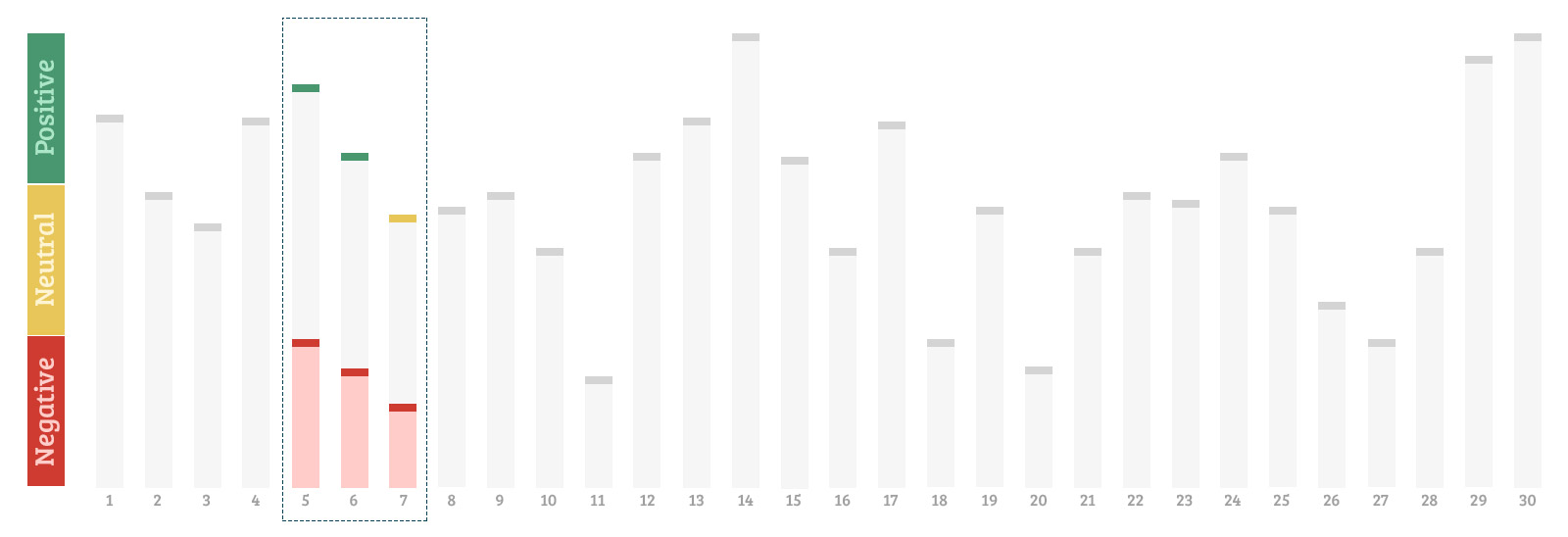
You’re probably starting to recognize gaps in the journey, and opportunities to bridge them. Take a look at the illustrated example above, and you might notice that touchpoints 5-7 are particularly troublesome. This is a series of negative experiences and may act as a barrier to progressing to later stages.
This would be an ideal area to prioritize investments into the experience. I like to think of these focus areas with a simple analogy:
You have $100 to spend on a journey of 100 touchpoints. It’s better to invest $25 into four different touchpoints than $1 into 100 different touchpoints.
Remember your user needs and experience principles? This is where they become particularly meaningful. If we know this persona needs to try new innovations that feel interesting, and we know this means the experience should feel modern, incorporate that into touchpoints 5-7! How can you make these interactions communicate innovation and feel modern?
There are countless articles out there about how using end-to-end customer journey maps can improve an overall customer experience, and even some team activity guides on how to involve key stakeholders in the process. Hopefully the workflow I’ve outlined on how I approach the exercise has been helpful to you! The best thing is there’s no wrong way to do this. As long as you’re empathizing with personas and understanding the journey from their perspective, then you’re doing it right. You don’t even need any specific artifact at the end of the exercise. A lengthy document would be just as effective as sticky notes on a conference room wall. The most important thing is what you learn in the process, the shared understanding of those insights, and a plan to move forward.
